- About us»
- Net income calculator»
- Population aging»
-
- Least developed regions»
-
- Average wage
- Material need benefits
- Meal allowance
- Counties of Slovakia
- Inflation
- Living and Subsistence Minimum
- Unemployment of Czechia and Slovakia
- NACE Classification
-
- Life expectancy
- Gender differences
- Youth unemployment and NEET
- Minimum wage in EU
- Unemployment rates of different age groups
- Share of salaries on GDP
- Employment rate
- NEET
- Percentage of employees ususally working at nights
- Long term unemployment
- Unemployment rate
-
- Bratislava and surroundings
- Kopanice
- Danube river
- lower Vah river
- middle Vár river
- upper Nitra river
- lower Nitra river
- Mining cities
- Kysuce a Orava
- upper Vah river - Liptov
- Spiš cities
- upper Hron river
- Juhoslovenská kotlina
- Košice fold and Torysa river
- upper Zemplín
- lower Zemplín
- EU regions
- NUTS3 regions of Slovakia
- LAU1 dataset
-
- Projects and activities
- Inclusive growth»
- Good work
- Project SKRS
- Social system – reality and vision
- Library
-
- Education of unemployed
- Young unemployed not taking part in education
- Proposal to change the system of education funding
- News»
- Contact
Tuscany – ITI1
EU regions: Italy > Central Italy > Tuscany
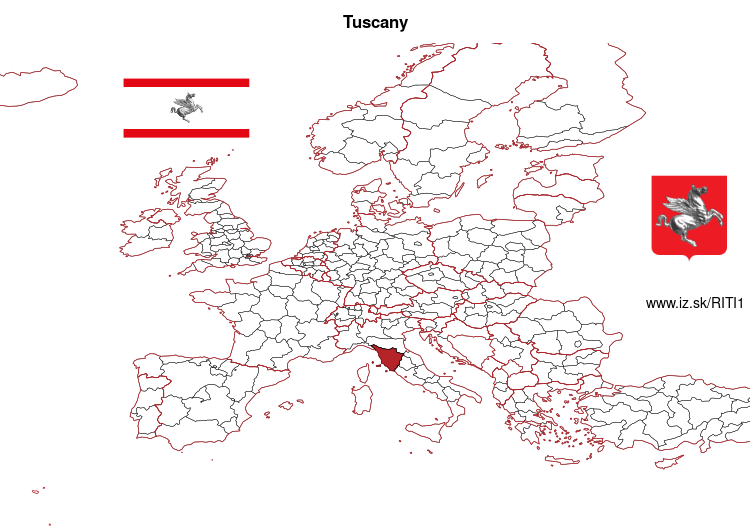
| Indicator | Period | Value |
|---|---|---|
| Life long learning | ||
| life long learning participation | 2024 | 11.6 |
| Part time jobs and flexible employment | ||
| percentage of part time workers | 2024 | 17.65 |
| percentage of part time workers, men | 2024 | 7.85 |
| percentage of part time workers, women | 2024 | 29.67 |
| Gender differences | ||
| gender gap in employment rate | 2024 | 81.56 |
| gender gap in unemployment rate | 2024 | 164.52 |
| Graduates and young people | ||
| unemployment rate of youth with elementary education | 2024 | 16.7 |
| NEET | 2024 | 8.7 |
| Gross domestic product | ||
| GDP per capita in PPS of EU average | 2023 | 103 |
| Employment | ||
| employment rate | 2024 | 70.9 |
| Social exclusion | ||
| people at risk of poverty or social exclusion | 2020 | 17.2 |
More on wikipedia wikidata Q1273 on OpenStreetMap Tuscany slovensky: ITI1
Subregions: Province of Massa-Carrara, Province of Lucca, Province of Pistoia, Province of Florence, Province of Prato, Province of Livorno, Province of Pisa, Province of Arezzo, Province of Siena, Province of Grosseto
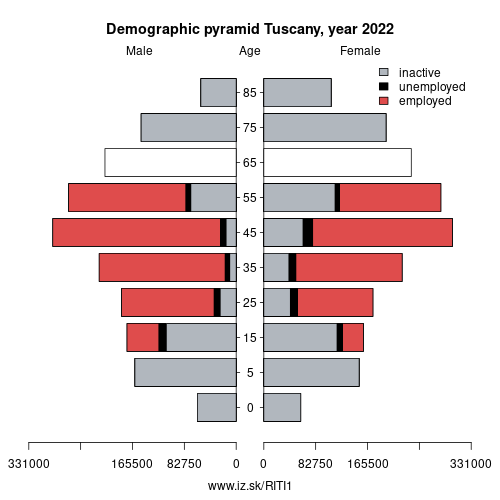
Unemployment
| Indicator | Period | Value |
|---|---|---|
| Unemployment | ||
| unemployment rate | 2024 | 4.1 |
| youth unemployment rate | 2024 | 13.4 |
| Long term unemployment | ||
| long term unemployment | 2024 | 1.2 |
| share of long term unemployed | 2024 | 31.1 |
Demographics
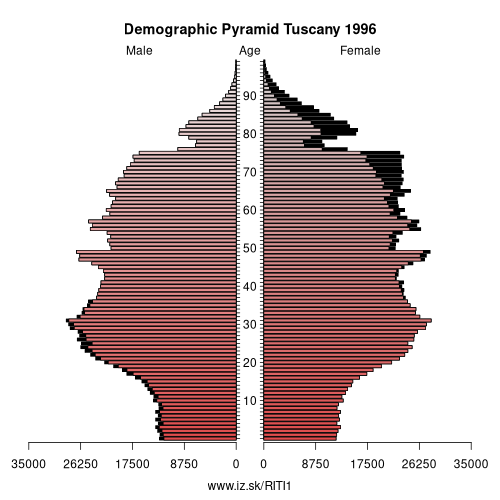
| Indicator | Period | Value |
|---|---|---|
| Demographics | ||
| number of inhabitants | 2024 | 3 660 530 |
| population density | 2023 | 160.6 |
| old-age dependency ratio | 2024 | 42.5 |
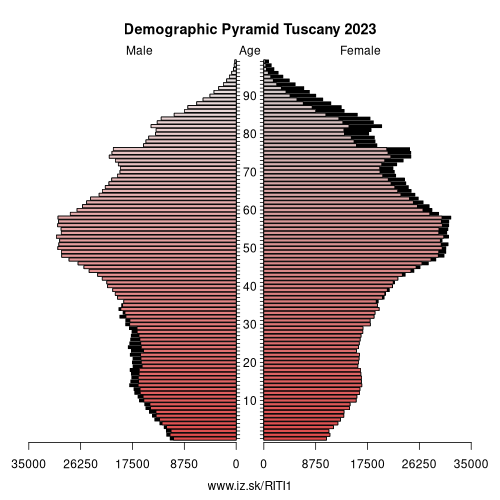
Employment by sectors, Tuscany
| NACE r2 | % | NACE r2 | % | ||
|---|---|---|---|---|---|
| A | 44.8 | 3% | B-E | 357.2 | 21% |
| F | 100.7 | 6% | G-I | 445.3 | 27% |
| J | 43.9 | 3% | K | 37.6 | 2% |
| L | 11.1 | 1% | M_N | 172.7 | 10% |
| O-Q | 321.5 | 19% | R-U | 133.1 | 8% |
| TOTAL | 1668 | 100% |
Data for the period year 2024. Source of the data is Eurostat, table [lfst_r_lfe2en2].
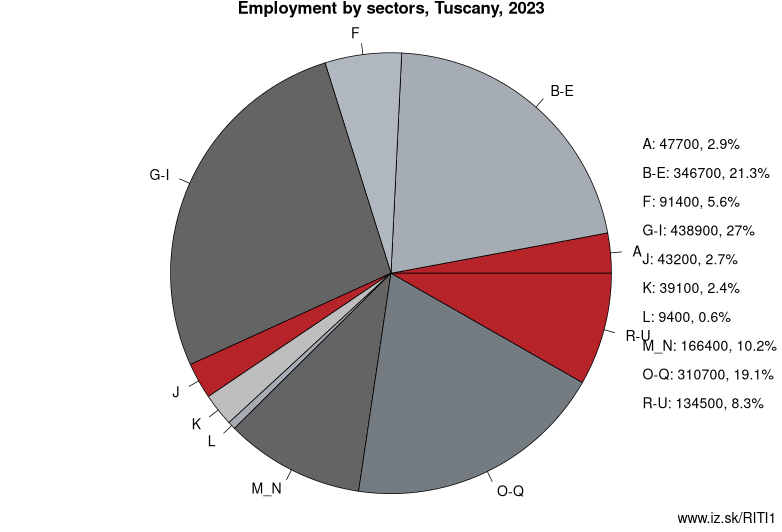
From Wikipedia: Tuscany ( TUSK-ə-nee; Italian: Toscana [toˈskaːna]) is a region in central Italy with an area of about 23,000 square kilometres (8,900 square miles) and a population of about 3.8 million inhabitants (2013). The regional capital is Florence (Firenze).
Tuscany is known for its landscapes, history, artistic legacy, and its influence on high culture. It is regarded as the birthplace of the Italian Renaissance and has been home to many figures influential in the history of art and science, and contains well-known museums such as the Uffizi and the Pitti Palace. Tuscany produces wines, including Chianti, Vino Nobile di Montepulciano, Morellino di Scansano and Brunello di Montalcino. Having a strong linguistic and cultural identity, it is sometimes considered „a nation within a nation".
Tuscany is a popular destination in Italy, the main tourist spots are Florence, Pisa, Lucca, Siena, Versilia, Maremma and Chianti. The village of Castiglione della Pescaia is the most visited seaside destination in the region, with seaside tourism accounting for approximately 40 % of tourist arrivals. Additionally, Siena, Lucca, the Chianti region, Versilia and Val d'Orcia are also internationally renowned and particularly popular spots among travellers.
Seven Tuscan localities have been designated World Heritage Sites: the historic centre of Florence (1982); the Cathedral square of Pisa (1987); the historical centre of San Gimignano (1990); the historical centre of Siena (1995); the historical centre of Pienza (1996); the Val d'Orcia (2004), and the Medici Villas and Gardens (2013).
Other: Central Italy, Lazio, Marche, Umbria, Tuscany
Neighbours: Lazio, Marche, Umbria, Liguria, Emilia-Romagna
Subregions: Province of Massa-Carrara, Province of Lucca, Province of Pistoia, Province of Florence, Province of Prato, Province of Livorno, Province of Pisa, Province of Arezzo, Province of Siena, Province of Grosseto
Suggested citation: Michal Páleník: Europe and its regions in numbers - Tuscany – ITI1, IZ Bratislava, retrieved from: https://www.iz.sk/PITI1, ISBN: 978-80-970204-9-1, DOI:10.5281/zenodo.10200164

 Share
Share Facebook
Facebook Twitter
Twitter News
News